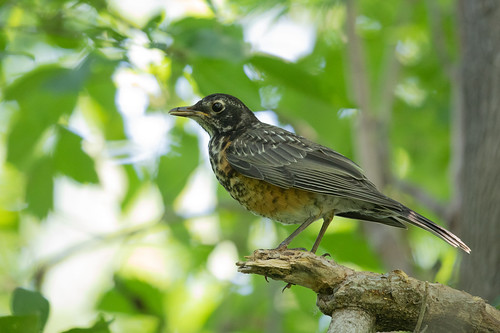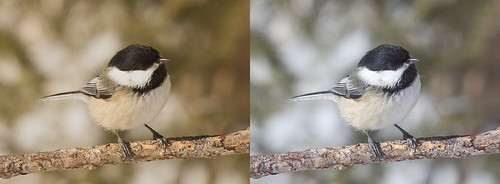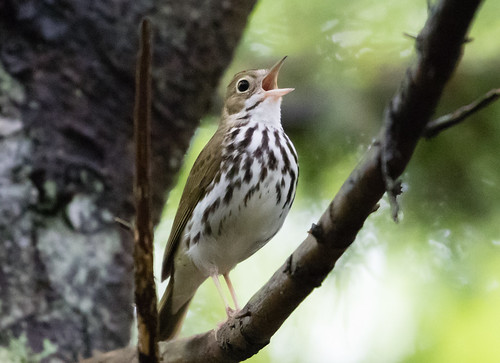Last December I had cataract surgery, first on my non-dominant right eye, and then two weeks later, on my left eye. During the fourteen days in between, I could directly compare how pristine colors were with the cataract-free eye by closing one eye and then the other.
Cataracts add a brownish yellow cast to everything. Without that, the sky was ever so much more beautiful, and many of the rooms in our house suddenly looked newly painted.
But we humans fairly quickly adjust to the everyday, and a month or two after getting the second eye done, being cataract free became an everyday condition. For a few days during spring migration, I noticed how brilliant migrant birds appeared, but even that quickly became the everyday norm.
 |
| It's hard to believe we could ever take such a bird for granted, but after a while, we do. |
After living on Peabody Street for 38 previous springs, I thought there was little left that would seem spectacular, and really, compared with many springs, this year’s was a rather late and lackluster migration. But my making sound recordings of my backyard birds almost every morning starting April 29, and really listening to those recordings through my headphones each day, suddenly made the commonplace more brilliant and gorgeous.
My stereo microphone allowed me to hear the general direction the songs were coming from, and I started being able to distinguish some individuals. I could pick out my two familiar robins nesting on the east and west sides of my yard and discovered that one regularly sang a pretty phrase I’d never associated with robins before. When the chickadees started singing well before sunrise, it was easy to hear two different males going back and forth, and sometimes I could pick out a more distant third. I listened for my Song Sparrows to pipe in, and the flickers nesting in the tiny woodlot behind my house. Goldfinches twittered away every day.
As May progressed, catbirds, thrashers, orioles, wrens, and Rose-breasted Grosbeaks joined the chorus. Usually I look for Ruby-throated Hummingbirds, but during May and early June, they often flew over my recorder, allowing me to pick out both their wing hums and their twittering notes. It was thrilling to pick out each brand new voice, but those voices were not just welcome as new year birds—this year, they sounded as wonderful as I remember when I was hearing each one for the very first time so many years ago.
All of these are commonplace birds. My friends who aren’t as high risk as I and so not under as strict social distancing rules were seeing a lot more birds, and I was reading a lot of wonderful reports of rare birds just a few miles from my house. But I never felt envious that I couldn’t bird outside my own yard. Paying such close attention to these ordinary bird songs through my headphones gave me the same kind of joy as, back in December, my cataract-free vision had.
I haven’t heard a Red-eyed Vireo in a couple of weeks, but soon one will pick up the slack on and off for most of the day, even into September. If I lived near good woods, or could go back in time to my own backyard in the 80s, I’d be hearing Ovenbirds piping in on and off all day, too. And when they were everyday birds instead of a hotline species, Evening Grosbeak calls would fill in every quiet moment. It's sad to think about Ovenbirds and grosbeaks disappearing from Peabody Street even as it's still lovely to enjoy what I do have. As June has dissolved into July, I’m still recording lots of bird song. But where in May and most of June my recordings were so packed with different individual singers that barely a second went by without at least one bird going at it, now there can be minutes-long lulls between song. Yes, little by little, the annual cycle of bird song is coming to an end. By the end of the month, I’ll be filling in the gap by using my camera instead of my sound recorder.
Disappointment could be the order of the day, but so soon after my cataract surgery experience, I’m suddenly seeing the annual cycle of bird song in a new light. Perhaps each bird must go through a long quiet time each year to reset its own everyday experience so that every spring, it’ll be experiencing gorgeous song with fresh ears all over again.
Framing it that way, I can read Robert Frost’s exquisite poem, The Oven Bird, with new ears:
There is a singer everyone has heard,Loud, a mid-summer and a mid-wood bird,Who makes the solid tree trunks sound again.He says that leaves are old and that for flowersMid-summer is to spring as one to ten.He says the early petal-fall is pastWhen pear and cherry bloom went down in showersOn sunny days a moment overcast;And comes that other fall we name the fall.He says the highway dust is over all.The bird would cease and be as other birdsBut that he knows in singing not to sing.The question that he frames in all but wordsIs what to make of a diminished thing.
Yes, even in mid-summer, the season of greatest abundance, as more and more fruits ripen and more and more baby birds flit about, some elements of the season can indeed seem diminished. But that is exactly as it should be. The birds don’t all quit singing at once. They taper off gently so we can adjust, but we are already sensing with certainty that they will eventually quit.
That autumnal hush may indeed seem a “diminished thing.” But unlike our aging bodies and minds, and treasured institutions we once had faith in that have grown tarnished, the diminishment of bird song as the season draws to a close won't be permanent. Bird song ebbs in summer so that come spring, we’ll once again hear it with fresh and hungry ears, drinking it in and enjoying it more fully, the way an everyday sky for a time seemed so amazingly fresh and brilliant to me, all because of that time of diminishment.



